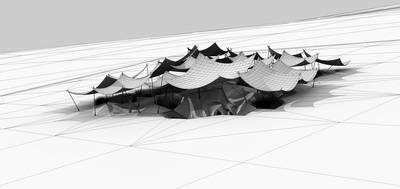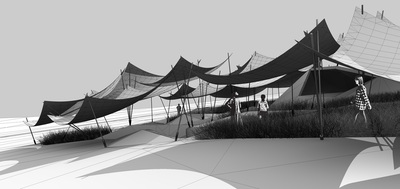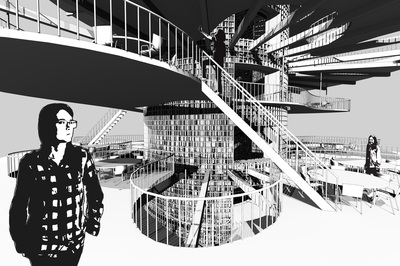< Back to Issue One: Table of Contents
[Architecture]
LINES & POWER
by Léopold Lambert
The line is essentially the medium that we use to create architecture. We consider a white page and trace a composition of lines that, far from mere representations, constitute the potential embodiment of surfaces in the material realm. Those same surfaces have an incidence –we might say a violence- on the bodies that are subjected to them. The act of drawing, in the context of design, cannot be innocent. The subjectivization of the bodies is precisely what constitutes a weapon and its management is the essence of politics. Architecture is therefore inherently political, whether it is intended as such or not. To try to defuse architecture would be useless. Instead, we might strive to use its weaponized characteristics in favor of personal or collective ethics.
My architectural work attempts to articulate itself within a context created by a society that proclaimed itself as “post-ideological.” Estimating architecture’s real power does not make it the thaumaturgic entity that the modernists perceived; on the contrary, we must recognize the violent characteristics embodied within it and use them in the frame of a political manifesto. - Léopold Lambert
[Architecture]
LINES & POWER
by Léopold Lambert
The line is essentially the medium that we use to create architecture. We consider a white page and trace a composition of lines that, far from mere representations, constitute the potential embodiment of surfaces in the material realm. Those same surfaces have an incidence –we might say a violence- on the bodies that are subjected to them. The act of drawing, in the context of design, cannot be innocent. The subjectivization of the bodies is precisely what constitutes a weapon and its management is the essence of politics. Architecture is therefore inherently political, whether it is intended as such or not. To try to defuse architecture would be useless. Instead, we might strive to use its weaponized characteristics in favor of personal or collective ethics.
My architectural work attempts to articulate itself within a context created by a society that proclaimed itself as “post-ideological.” Estimating architecture’s real power does not make it the thaumaturgic entity that the modernists perceived; on the contrary, we must recognize the violent characteristics embodied within it and use them in the frame of a political manifesto. - Léopold Lambert
1 & 2 My work from The Lost Line (2010) dramatizes an exploration into the thickness of the line. The line of a material wall, which separates two milieus, is rendered with ambiguity when considered from this relative perspective. The dark matter of the pencil’s graphite hosts some white cavities that create a labyrinth. Crossing the line/wall becomes possible by delving inside this maze and exiting “on the other side.”
3 & 4 Spiculation (2008, with Martin Le Bourgeois): This matter is composed of a multitude of small objects whose form and volume allow its aggregation without the help of any additional material (glue, nails, joints etc.). The architecture formed by this body constitutes the materialization of an individual or collective desire.
5 & 6 Weaponized Architecture (2012) is a book that examines the inherent instrumentalization of architecture as a political weapon. Rather than defusing this phenomenon, the project attempts to integrate it within the scene of a political struggle. The proposed project is manifested as a Palestinian shelter, with an associated agricultural platform. The shelter constitutes both an architectural design and a creatively integrated narrative of uncertainty and disobedience. In the structure we find a dramatic resistance to the colonial legislation imposed on Palestinian territory.
7 & 8 The Flakturm Archives (2012) is an architectural project that considers one of the anti-aircraft defense towers built in Vienna during the Second World War. The project uses the defensiveness of the existing building to place the archives of a civilization within its core. The will to store books within a gigantic bunker constitutes, of course, a literal gesture of protection for the books, but more importantly it encourages its visitors to reflect on the importance of the books’ physicality.
< Previous
Next >
3 & 4 Spiculation (2008, with Martin Le Bourgeois): This matter is composed of a multitude of small objects whose form and volume allow its aggregation without the help of any additional material (glue, nails, joints etc.). The architecture formed by this body constitutes the materialization of an individual or collective desire.
5 & 6 Weaponized Architecture (2012) is a book that examines the inherent instrumentalization of architecture as a political weapon. Rather than defusing this phenomenon, the project attempts to integrate it within the scene of a political struggle. The proposed project is manifested as a Palestinian shelter, with an associated agricultural platform. The shelter constitutes both an architectural design and a creatively integrated narrative of uncertainty and disobedience. In the structure we find a dramatic resistance to the colonial legislation imposed on Palestinian territory.
7 & 8 The Flakturm Archives (2012) is an architectural project that considers one of the anti-aircraft defense towers built in Vienna during the Second World War. The project uses the defensiveness of the existing building to place the archives of a civilization within its core. The will to store books within a gigantic bunker constitutes, of course, a literal gesture of protection for the books, but more importantly it encourages its visitors to reflect on the importance of the books’ physicality.
< Previous
Next >








